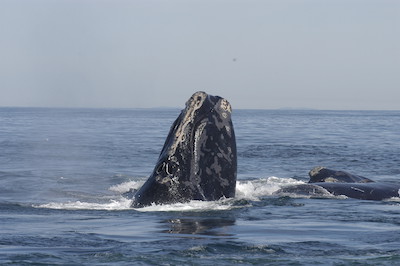Strikepods to Monitor Right Whales

The North Atlantic right whale. Wikimedia Commons
The following is a work of speculative fiction, or FICINT (fiction intelligence).
Through a unique partnership with marine conservation and environmental organizations, Strikepods will be deployed to the waters off New England and Nova Scotia to protect the highly endangered North Atlantic right whale.
Despite enjoying protection since the 1930s after being hunted nearly to extinction, the North Atlantic right whale population has struggled to rebound.
-
Given that they are coastal creatures, North Atlantic right whales are particularly vulnerable to ship strikes and are at increased risk of entanglement in fishing lines.
-
Though their population enjoyed a brief rebound in the late 20th century, North Atlantic right whales only number around 450, and with only 100 breeding females bearing one calf every three to five years, scientists fear that without drastic measures, extinction could be as close as twenty years away.
Operation Northern Swarm will augment protective measures currently in place by providing persistent and wide-area monitoring of the whales as they dwell in their feeding grounds off the New England coast.
-
Eighty Atom-class microsubmarines will be deployed from USCGC SPENCER at a location approximately 150 miles off the coast of Boston, MA.
-
There, the Atoms will organize into four twenty-ship Strikepods and, in close cooperation with air support and in-theater undersea gliders, sweep the habitat area (approximately 30,000 square miles), south to Massachusetts and Cape Cod Bays, the Stellwagen Bank, and coastal Cape Cod, and north to the Bay of Fundy and coastal Nova Scotia.
-
Upon contact, two-ship "splinter" Strikepods will be deployed to monitor, from a non-threatening distance, each individual or pod of whales.
-
To avoid disturbing the mammals, Strikepods will utilize passive sonar for detection and tracking, relying on vocalizations, respiration, feeding, and "hull turbulence" as the whales move through the water.
For the first time, sophisticated anti-submarine warfare (ASW) technologies and tactics will be brought to bear against threats to marine life.
-
Each splinter Strikepod will be comprised of two Atom-class microsubmarines, one designated a relay and the other a remora.
-
The relay will remain at or near the ocean surface in order to provide real-time data to partner organizations, and to act as an AIS transceiver, while the remora will be charged with tracking. For purposes of Northern Swarm, remora mode will be non-contact - i.e. limited to acoustic tracking only.
-
The whale's location, speed, bearing, and heading will be displayed on all AIS-enabled vessels in an effort to reduce the risk of collision.
-
If the relay detects that a collision is imminent, it will transmit a special warning broadcast via AIS directly to the inbound threat.
-
If acoustic data suggests a whale is struggling or in distress (as from entanglement), both the remora and relay will collect imagery (undersea and surface) which will then be transmitted to partner organizations to determine if intervention/rescue is needed.
Operation Northern Swarm is currently scheduled to commence in the Spring of 2019, after the whales migrate north from their calving grounds off the coast of the southeastern United States.
[End]
Strikepod Command

